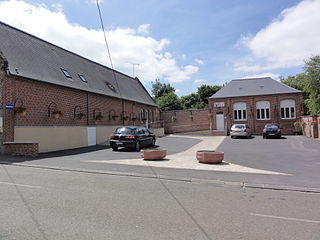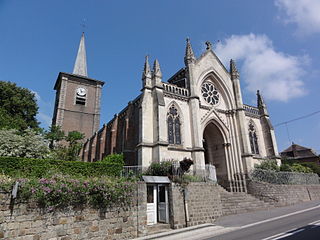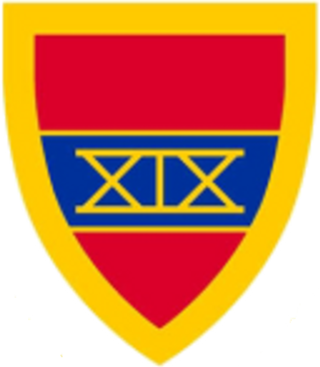William Henry Locke was a chaplain for the Union during the American Civil War. In his book, The Story of the Regiment , he told the story of the 11th Pennsylvania Infantry Regiment.

The Special Air Service (SAS) is a special forces unit of the British Army. It was founded as a regiment in 1941 by David Stirling, and in 1950 it was reconstituted as a corps. The unit specialises in a number of roles including counter-terrorism, hostage rescue, direct action and special reconnaissance. Much of the information about the SAS is highly classified, and the unit is not commented on by either the British government or the Ministry of Defence due to the secrecy and sensitivity of its operations.

The Welsh Guards, part of the Guards Division, is one of the Foot Guards regiments of the British Army. It was founded in 1915 as a single-battalion regiment, during the First World War, by Royal Warrant of George V. Shortly after the regiment's formation, it was deployed to France where it took part in the fighting on the Western Front until the end of the war in November 1918. During the inter-war years, the regiment undertook garrison duties in the United Kingdom, except between 1929 and 1930 when it deployed to Egypt, and late 1939 when it deployed to Gibraltar.

The 21 Special Air Service Regiment (Artists) (Reserve), historically known as The Artists Rifles is a regiment of the Army Reserve. Its name is abbreviated to 21 SAS(R).

The Guards Museum is a military museum in Central London, England. It is in Wellington Barracks on Birdcage Walk near Buckingham Palace, which is the home of the five regiments of Foot Guards.

Brockdish is a village and civil parish in the South Norfolk district of Norfolk, England. The village is situated on the River Waveney, and is about 3 miles (5 km) south-west of Harleston.
The Delaware Line was a formation within the Continental Army. The term "Delaware Line" referred to the quota of one infantry regiment which was assigned to Delaware at various times by the Continental Congress. This, together with similar contingents from the other twelve states, formed the Continental Line. The concept was particularly important in relation to the promotion of commissioned officers. Officers of the Continental Army below the rank of brigadier general were ordinarily ineligible for promotion except in the line of their own state.
"Sharpe's Christmas" is a short story by historical fiction author Bernard Cornwell. It features Cornwell's fictional hero Richard Sharpe. It was originally written for the British newspaper The Daily Mail, which serialised it during the 1994 Christmas season. An extended version was published by The Sharpe Appreciation Society in a short story collection of the same name in 2003 to raise funds for The Bernard and Judy Cornwell Foundation.
The 88th Regiment of Foot (Highland Volunteers), or Campbell's Highlanders, was a Scottish infantry regiment in the British Army, formed in 1760 and disbanded in 1763.
The 87th Regiment of Foot (Keith's Highlanders) was a Scottish infantry regiment in the British Army, formed in 1759 and disbanded in 1763.

Iron is a commune in the Aisne department in Hauts-de-France in northern France.

Bligny-sur-Ouche is a commune in the Côte-d'Or department in eastern France.

Vendegies-sur-Écaillon is a commune in the Nord department in northern France.
At the beginning of August 1916, three French and one British division with 45,000 men and 400 guns launched an offensive against the Bulgarian positions at Lake Dojran, defended by the 2nd Thracian Infantry Division. The attack began on 9 August with heavy artillery fire on the positions of the 27th Chepino Regiment and 9th Plovdiv Regiment. All four attacks that followed on 10, 15, 16 and 18 August were repulsed by the Second Division, and the Allies were forced to retreat to their original positions with heavy casualties.

The Queen's Own Oxfordshire Hussars (QOOH) was a Yeomanry Cavalry regiment of the British Army's auxiliary forces, formed in 1798. It saw service in the Second Boer War with 40 and 59 Companies of the Imperial Yeomanry and was the first Yeomanry regiment to serve in Belgium and France during the Great War. After almost four years of Trench warfare on the Western Front, where cavalry had been superfluous, the QOOH led the advance during the Allies' victorious Hundred Days Offensive in 1918. In 1922, the QOOHt became part of the Royal Artillery and during World War II it served as anti-tank gunners at Singapore and in North West Europe. After a series of postwar mergers and changes of role, the regiment's lineage is maintained by 142 Vehicle Squadron, Royal Logistic Corps.

Brock Barracks is a British Army barracks in the town of Reading in the English county of Berkshire. Located on Oxford Road in the district of West Reading. The majority of the buildings and structures within Brock Barracks are Grade II listed.
The 19th Infantry Division was a formation of the Ottoman Army, during the Balkan Wars and the First World War.
The 9th Infantry Division was a formation of the Ottoman Turkish Army, during the Balkan Wars, and the First World War.

The Umkhonto Field Engineer Regiment is a regiment of the South African Army Engineer Formation. The unit is based in Durban with the HQ being at Old Fort Military Base, Lord's Grounds. As a reserve unit, it has a status roughly equivalent to that of a British Army Reserve or United States Army National Guard unit.

A Dog of the Regiment is a 1927 American synchronized sound drama film directed by D. Ross Lederman. While the film has no audible dialog, it was released with a synchronized musical score with sound effects using the Vitaphone sound-on-disc process. This film is presumed lost. According to Warner Bros records the film earned $188,000 domestic and $59,000 foreign.
The 1916 Birthday Honours were appointments by King George V to various orders and honours to reward and highlight good works by citizens of the British Empire. The appointments were made to celebrate the official birthday of The King, and were published in The London Gazette and in The Times on 3 June 1916.